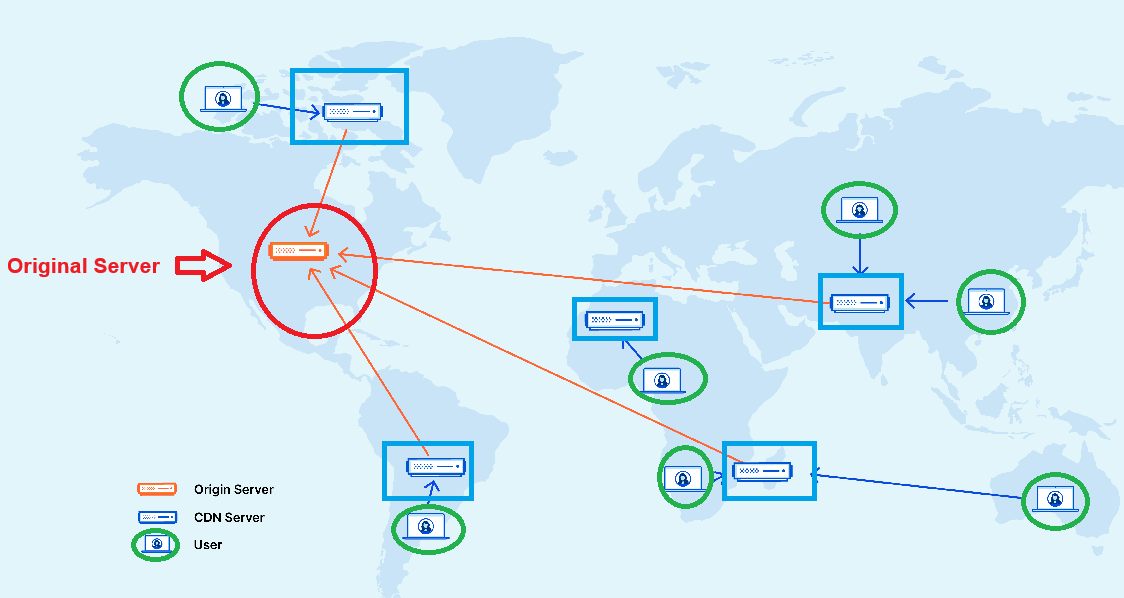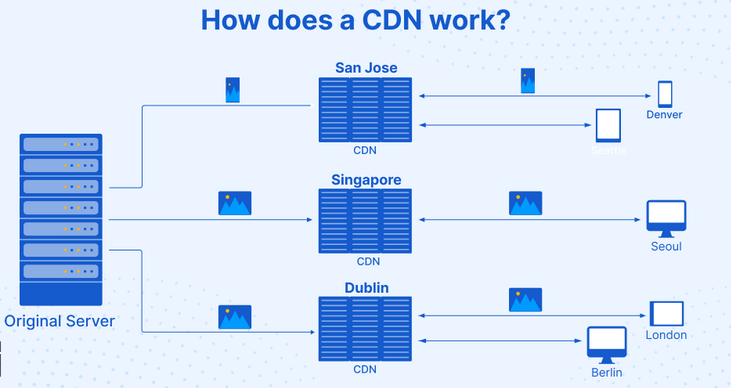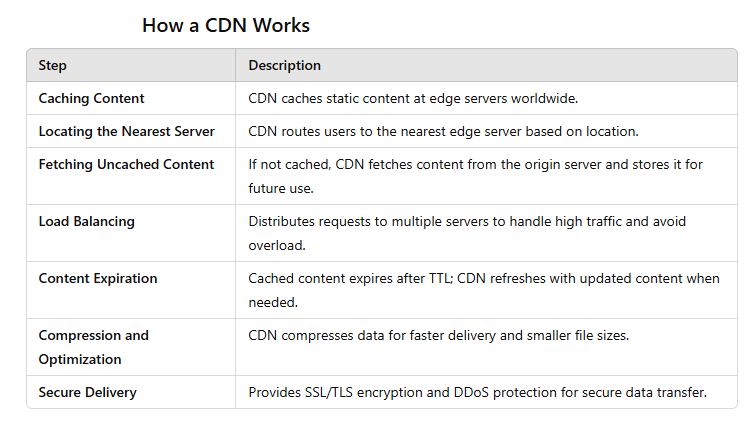A CDN (Content Delivery Network) works by distributing and delivering web content (like HTML, images, videos, JavaScript, and CSS files) from servers that are geographically closer to the user, instead of relying solely on a single origin server. This improves speed, reliability, and security.

- How Does CDN Work ?
How Does CDN Work ?
A content delivery network relies on three types of servers.
- Origin servers. Origin servers contain the original versions of content and they function as the source of truth. Whenever content needs to be updated, changes are made on the origin server. An origin server may be owned and managed by a content provider or it may be hosted on the infrastructure of a third-party cloud provider like Amazon’s AWS S3 or Google Cloud Storage.
- Edge servers. Edge servers are located in multiple geographical locations around the world, also called “points of presence” (PoPs). The edge servers within these PoPs cache content that is copied from origin servers, and they are responsible for delivering that content to nearby users. When a user requests access to content on an origin server, they are redirected to a cached copy of the content on an edge server that’s geographically close to them. When cached content is out of date, the edge server requests updated content from the origin server. CDN edge servers are owned or managed by the CDN hosting provider.
- DNS servers. Domain Name System (DNS) servers keep track of and supply IP addresses for origin and edge servers. When a client sends a request to an origin server, DNS servers respond with the name of a paired edge server from which the content can be served faster.
How a CDN Works (Step by Step)
1. User Requests Content
When a user visits your website (e.g., example.com), their browser requests content like image.jpg or index.html.
2. DNS Redirection to the Nearest Edge Server
The DNS system directs the request to the nearest CDN edge server (also called a Point of Presence or PoP) based on:
- Geographic proximity
- Server load
- Network conditions
3. Edge Server Responds
- If the content is cached on that edge server, it is immediately served to the user.
- If not, the edge server fetches it from the origin server, caches it, and then serves it to the user.
4. Content Caching
- Static assets (e.g., images, JS, CSS) are stored on the edge servers for a period (defined by cache rules).
- Next time, the same or another nearby user gets the cached version—faster, and without hitting your main server.
🧠 Key Concepts in CDN Functionality
| Concept | Explanation |
|---|---|
| Edge Server | A server in a PoP near the user, used to deliver content quickly. |
| Caching | Temporarily storing content so it can be reused for future requests. |
| Origin Server | Your main web server where the original content lives. |
| TTL (Time to Live) | How long content stays cached before checking for updates. |
| Geo-routing | Directing traffic to the nearest or best-performing edge server. |
| Dynamic Content Acceleration | Some CDNs can also speed up dynamic (non-cached) content by optimizing routes. |
If you were in New York and wanted to view the website of your favorite store in London that’s hosted on a server in the U.K., you would experience slow content load times if the request had to travel all the way across the Atlantic Ocean. To remedy this, a CDN would store a cached version of the London website content in multiple geographical locations around the world (PoPs). These PoPs contain their own caching servers and are responsible for delivering that content close to where you’re located in New York.
To deliver the optimal viewing experience, CDNs perform two essential functions.
- Reduce latency. Latency is that annoying delay you experience when trying to access a web page or video stream before it fully loads on your device. Although measured in milliseconds, it can feel like forever, and it may even result in a load error or time-out. Some content delivery networks alleviate latency by reducing the physical distance that the content needs to travel to reach you. Therefore, larger and more widely distributed CDNs are able to deliver website content more quickly and reliably by putting the content as close to the end user as possible.
- Balance loads. A CDN balances overall traffic to give everyone accessing internet content the best web experience possible. Think about it like routing traffic in the real world. There may be one route that’s usually the fastest from point A to point B if no other cars take it — but if it starts getting congested, it’s better for everyone if the traffic gets spread out over a few different routes. That may mean that you get sent on a roadway that’s a few minutes longer (or milliseconds, when scaled to internet speeds), but you don’t get stuck in the traffic jam that’s forming on the shortest route. Load balancing enables content providers to handle increases in demand and large traffic spikes while still providing high-quality user experiences and avoiding downtime.
What a CDN Typically Delivers
- Static content: Images, CSS, JS, fonts, videos, PDFs
- Dynamic content (with smart routing or edge computing)
- APIs and JSON responses
- Software downloads
- Live video streaming
The benefits of a CDN
CDNs carry a large portion of the world’s internet traffic. They help solve the toughest challenges of delivering content over the internet. From small and medium content providers to the world’s large corporations, businesses everywhere take advantage of key CDN benefits to provide a seamless web experience to their customers.
- Boost performance. Performance is the difference between a click giving you immediate access to new content and a click followed by a seven-second wait while a page loads or a video buffers. That wait time is called “buffering” and is symbolized by a familiar swirling circle icon on the screen. To ensure high performance and minimize buffering, CDNs deliver content that’s been pre-saved on nearby servers on the CDN’s network rather than sending requests to origin servers which may be halfway around the world. If the content isn’t already pre-saved, the CDN uses its programmed knowledge of the necessary connections to overcome any challenges. Advanced CDNs use additional technologies that resolve any issues in the delivery of uncacheable dynamic content and to determine the appropriate type of content to deliver to different devices. With CDNs, content providers can deliver fast, quality web experiences to all their end users; no matter what location, browser, device, or network they’re connecting from. Web pages render more quickly, video buffering time is reduced, and website visitors stay more engaged.
- Ensure availability. Availability means that content remains accessible to end users even during periods of excessive user traffic when many people are accessing content at the same time or if there are server outages in some parts of the internet. When traffic loads peak at millions of requests per second, even the most powerful servers are put to the test. Without a content delivery network, all this traffic must be absorbed by a content provider’s infrastructure. This can cause failures and poor end-user experiences. The widely distributed server infrastructure offered by CDNs is designed to alleviate these issues. Advanced CDNs, with their highly distributed architecture and massive platform of servers, can absorb 100+ Tbps of traffic and make it possible for content providers to stay available to even larger user bases.
- Enhance security. CDNs can also improve website security with increased protection against malicious actors and threats like distributed denial-of-service (DDoS) attacks. Today’s most advanced content delivery networks provide unique cloud-based security solutions and DDoS protection.
- Gather intelligence. As carriers of nearly half of the world’s internet traffic, CDN providers generate vast amounts of data about end-user connectivity, device types, and browsing experiences across the globe. This data can provide CDN customers with critical, actionable intelligence and insights into their user base. Intelligence from CDNs also enables services such as real user monitoring, media analytics that measure end-user engagement with web content, and cloud security intelligence to keep track of online threats.
- Improve customer experiences. Content, application, and website owners — including ecommerce sites, media properties, and cloud computing companies — use CDNs to improve customer experiences, lower abandonment rates, increase ad impressions, improve conversion rates, and strengthen customer loyalty.
- Offload traffic. With the explosive growth of online streaming and other rich media services, and higher user expectations about web performance across multiple device types, many of today’s network service providers are finding their content distribution networks to be highly stressed. By responding to a request for web content with a cached version from servers closer to the end user, a CDN can offload traffic from content servers and improve the web experience.
- Reduce bandwidth costs. By delivering content from servers closer to users, CDNs reduce bandwidth consumption and the associated costs.
Almost everyone that accesses the web uses a CDN. They were created to provide a faster and more reliable experience for people accessing the internet. They are used by the content and application owners and network service providers that supply those benefits to their customers.
CDNs for end users
Websites and web applications delivered through a CDN experience faster page loads, faster transactions, and a more consistent online experience. However, people may have no idea they are connecting through a content delivery network as they enjoy its benefits, because the technology works behind the scenes. They simply receive what they requested from their ISP or mobile provider.
CDNs for content owners
Content and application owners use CDNs to improve customer experiences. Using a content delivery network can also improve web security, for instance by helping to absorb and mitigate a DDoS attack.
CDNs for network service providers
Many of today’s network service providers are finding it necessary to deploy their own content distribution networks. For network operators, deploying a content delivery network can reduce subscriber churn, facilitate the development of value-added services, reduce traffic on the core network, and enable operators to sell CDN services to enterprises and third-party content owners.
One of the biggest benefits of a CDN is offload. By responding to a request for web content with a cached version in closer physical and network proximity to the end user — instead of from the server where the content originates — a CDN offloads traffic from content servers and improves the web experience. This means that content can stay within the network operator’s network and reduce the need to engage in peering with other networks or navigating the broader internet to deliver information.



A CDN (Content Delivery Network) works by distributing and delivering web content (like HTML, images, videos, JavaScript, and CSS files) from servers
[See the full post at: How Does a CDN work?]
How Does a CDN work?
Related posts:
Related posts: